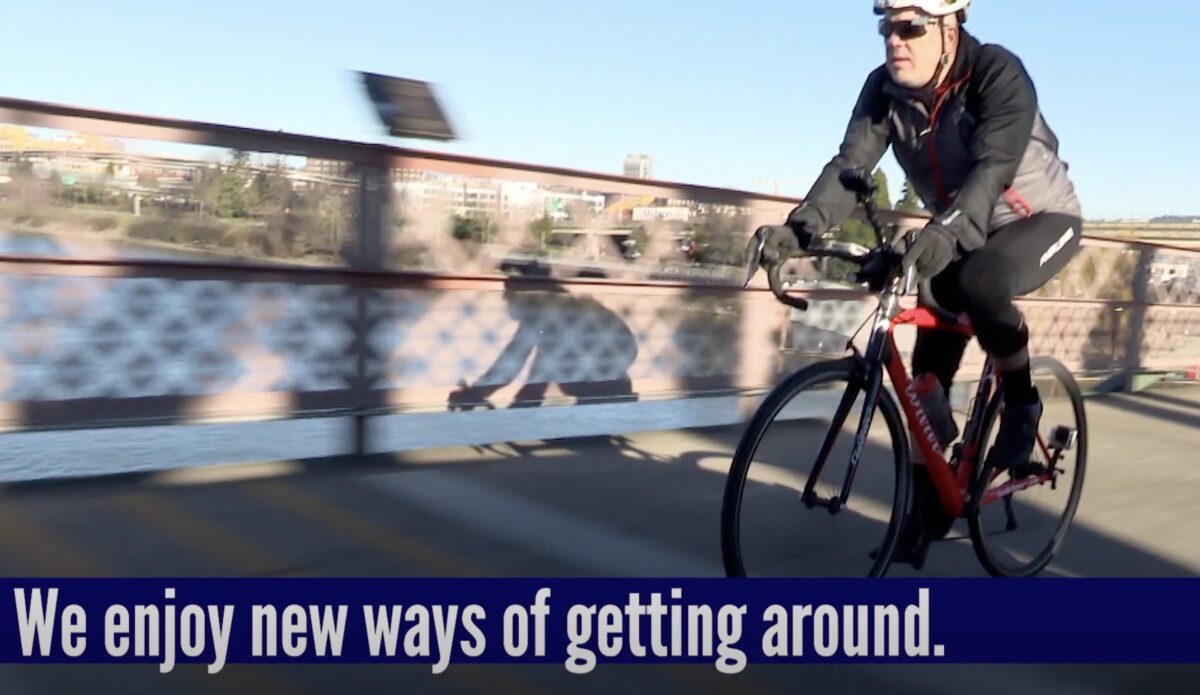
(Graphic: ODOT Strategic Action Plan)
“In order to create this system and meet the demands ahead, ODOT must evolve.”
— from Strategic Plan introduction letter
The Oregon Department of Transportation is the largest barrier to significant reform of our transportation system. The agency holds the pursestrings and levers of power that dictate just how quickly we can move from a driving and highway-dominated infrastructure and policy framework, to a more humane and earth-friendly one.
The agency’s 2021-2023 Strategic Action Plan, adopted by the Oregon Transportation Commission late last year, is a window into what ODOT thinks of itself and what steps they’ll take to reform themselves. Part policy and part propaganda, it can also be used as a tool for Oregonians to hold the agency accountable.
Advertisement
“Oregon’s transportation system of the future… will offer a wide range of mobility choices to promote a healthy environment and respond to the diverse mobility needs of those who use the transportation system, including those that the system has not served well in the past,” reads an introduction to the 26-page plan signed by OTC Chair Bob Van Brocklin and ODOT Director Kris Strickler. “In order to create this system and meet the demands ahead, ODOT must evolve. An organization with the tools, ideas, and perspectives of the past is unprepared to meet the needs of the future… Change starts now.”
A short video introduction to the plan (below) was released on Tuesday.
Amid a backdrop of droning meditative music, a graphic in the photo claims our transportation system was, “Born in 1913.” That date aligns with the formation of the State Highway Commission, but it glosses over the fact that several Oregon cities already had functioning transportation systems without cars or highways. Portland and Eugene had trolleys and streetcars long before the Highway Commission was established. And let’s not forget the detailed road network illustrated in the “Cyclists Road Map of Portland District” published in 1896. That’s the same year Portland’s Union Station opened for business.
This might feel like nitpicking (something I admittedly tend to do when covering government agencies), but the perspective that cars and highways are the foundation of Oregon’s transportation system reinforces their primacy. This is how the status quo maintains its power. It didn’t go unnoticed to me that the photo in the video accompanied by “We enjoy new ways of getting around,” showed a man on a bicycle, as if bicycle riders are some strange new interloper, when the reality is that bicycles dominated roads throughout Oregon long before the first car was ever sold.
To ODOT’s credit, the Strategic Action Plan calls for a “transformation,” and “change” which can (charitably) be read as an admission that the agency is currently on the wrong track.
The meat of the plan are three “Priority Areas” and 10 “Strategic Outcomes”.
The three priorities are: “Modern Transportation System” (and yes people likely have different ideas of what “modern” means), “Sufficient and Reliable Funding” (especially important if you like to build expensive freeways), and “Equity”.
Advertisement
The 10 strategic outcomes include very admirable goals:
1. Increase Our Workforce Diversity
2. Implement a Social Equity Engagement Framework
3. Reduce Our Carbon Footprint
4. Electrify Oregon’s Transportation System
5. Improve Access to Active and Public Transportation
6. Reduce Congestion in the Portland Region
7. More Dollars to Black, Indigenous, People of Color and Women Owned Businesses
8. Implement Transformative Technologies
9. Implement Large-scale Road Usage Charging
10. Achieve Sufficient Funding
When it comes to reducing their carbon footprint, ODOT promises that by the end of 2023 they’ll “begin to reduce greenhouse gas emissions from ODOT activities.” ODOT also says that starting next year they’ll, “Adjust investment programs to invest in lower emission projects (e.g. bike, walk, transit).”
As for improving access to active transportation and public transit, ODOT promises that by the end of 2023 they will, “increase the percentage of agency funding dedicated to projects and programs that improve equitable access to walking, biking and transit.”
Advertisement
We’ve already seen some action from ODOT on both of these fronts. The new priority to reduce GHG emissions came into play with the latest Statewide Transportation Improvement Program (STIP) funding allocation decision. Last month the OTC voted to spend a record amount on “non-highway” projects.
The biggest debates in the next three years are likely to be around how ODOT plans to “Reduce congestion in the Portland region” while staying true to the goals outlined in this plan. Undeterred by widespread local opposition, the Strategic Plan boldly proclaims ODOT will begin construction on the I-5 Rose Quarter project by 2023 and will, “Begin making investments in the Portland region to reduce traffic congestion as defined by the average number of hours per day a driver experiences congestion.”
If ODOT undertakes that work with the, “tools, ideas, and perspectives of the past” they won’t meet their goals. A planning document has never been enough for ODOT to make the real and lasting changes our state needs — it must be accompanied by pressure from outside leaders and the public.
— Jonathan Maus: (503) 706-8804, @jonathan_maus on Twitter and jonathan@bikeportland.org
— Get our headlines delivered to your inbox.
— Support this independent community media outlet with a one-time contribution or monthly subscription.




